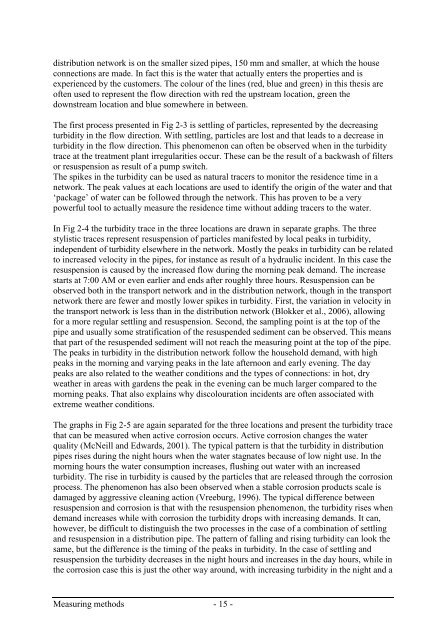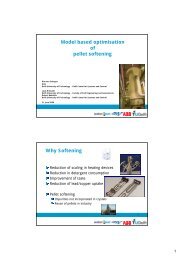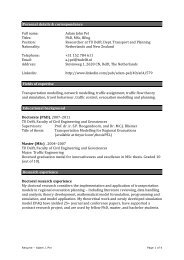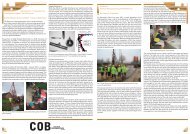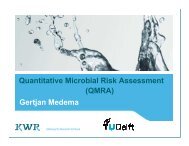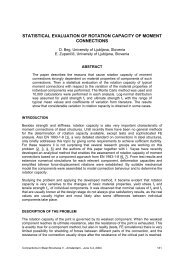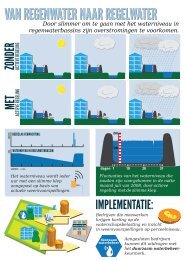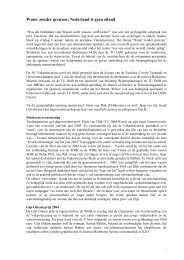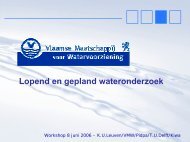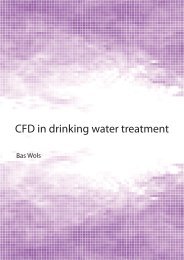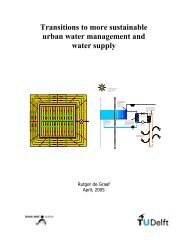Discolouration in drinking water systems - TU Delft
Discolouration in drinking water systems - TU Delft
Discolouration in drinking water systems - TU Delft
You also want an ePaper? Increase the reach of your titles
YUMPU automatically turns print PDFs into web optimized ePapers that Google loves.
distribution network is on the smaller sized pipes, 150 mm and smaller, at which the house<br />
connections are made. In fact this is the <strong>water</strong> that actually enters the properties and is<br />
experienced by the customers. The colour of the l<strong>in</strong>es (red, blue and green) <strong>in</strong> this thesis are<br />
often used to represent the flow direction with red the upstream location, green the<br />
downstream location and blue somewhere <strong>in</strong> between.<br />
The first process presented <strong>in</strong> Fig 2-3 is settl<strong>in</strong>g of particles, represented by the decreas<strong>in</strong>g<br />
turbidity <strong>in</strong> the flow direction. With settl<strong>in</strong>g, particles are lost and that leads to a decrease <strong>in</strong><br />
turbidity <strong>in</strong> the flow direction. This phenomenon can often be observed when <strong>in</strong> the turbidity<br />
trace at the treatment plant irregularities occur. These can be the result of a backwash of filters<br />
or resuspension as result of a pump switch.<br />
The spikes <strong>in</strong> the turbidity can be used as natural tracers to monitor the residence time <strong>in</strong> a<br />
network. The peak values at each locations are used to identify the orig<strong>in</strong> of the <strong>water</strong> and that<br />
‘package’ of <strong>water</strong> can be followed through the network. This has proven to be a very<br />
powerful tool to actually measure the residence time without add<strong>in</strong>g tracers to the <strong>water</strong>.<br />
In Fig 2-4 the turbidity trace <strong>in</strong> the three locations are drawn <strong>in</strong> separate graphs. The three<br />
stylistic traces represent resuspension of particles manifested by local peaks <strong>in</strong> turbidity,<br />
<strong>in</strong>dependent of turbidity elsewhere <strong>in</strong> the network. Mostly the peaks <strong>in</strong> turbidity can be related<br />
to <strong>in</strong>creased velocity <strong>in</strong> the pipes, for <strong>in</strong>stance as result of a hydraulic <strong>in</strong>cident. In this case the<br />
resuspension is caused by the <strong>in</strong>creased flow dur<strong>in</strong>g the morn<strong>in</strong>g peak demand. The <strong>in</strong>crease<br />
starts at 7:00 AM or even earlier and ends after roughly three hours. Resuspension can be<br />
observed both <strong>in</strong> the transport network and <strong>in</strong> the distribution network, though <strong>in</strong> the transport<br />
network there are fewer and mostly lower spikes <strong>in</strong> turbidity. First, the variation <strong>in</strong> velocity <strong>in</strong><br />
the transport network is less than <strong>in</strong> the distribution network (Blokker et al., 2006), allow<strong>in</strong>g<br />
for a more regular settl<strong>in</strong>g and resuspension. Second, the sampl<strong>in</strong>g po<strong>in</strong>t is at the top of the<br />
pipe and usually some stratification of the resuspended sediment can be observed. This means<br />
that part of the resuspended sediment will not reach the measur<strong>in</strong>g po<strong>in</strong>t at the top of the pipe.<br />
The peaks <strong>in</strong> turbidity <strong>in</strong> the distribution network follow the household demand, with high<br />
peaks <strong>in</strong> the morn<strong>in</strong>g and vary<strong>in</strong>g peaks <strong>in</strong> the late afternoon and early even<strong>in</strong>g. The day<br />
peaks are also related to the weather conditions and the types of connections: <strong>in</strong> hot, dry<br />
weather <strong>in</strong> areas with gardens the peak <strong>in</strong> the even<strong>in</strong>g can be much larger compared to the<br />
morn<strong>in</strong>g peaks. That also expla<strong>in</strong>s why discolouration <strong>in</strong>cidents are often associated with<br />
extreme weather conditions.<br />
The graphs <strong>in</strong> Fig 2-5 are aga<strong>in</strong> separated for the three locations and present the turbidity trace<br />
that can be measured when active corrosion occurs. Active corrosion changes the <strong>water</strong><br />
quality (McNeill and Edwards, 2001). The typical pattern is that the turbidity <strong>in</strong> distribution<br />
pipes rises dur<strong>in</strong>g the night hours when the <strong>water</strong> stagnates because of low night use. In the<br />
morn<strong>in</strong>g hours the <strong>water</strong> consumption <strong>in</strong>creases, flush<strong>in</strong>g out <strong>water</strong> with an <strong>in</strong>creased<br />
turbidity. The rise <strong>in</strong> turbidity is caused by the particles that are released through the corrosion<br />
process. The phenomenon has also been observed when a stable corrosion products scale is<br />
damaged by aggressive clean<strong>in</strong>g action (Vreeburg, 1996). The typical difference between<br />
resuspension and corrosion is that with the resuspension phenomenon, the turbidity rises when<br />
demand <strong>in</strong>creases while with corrosion the turbidity drops with <strong>in</strong>creas<strong>in</strong>g demands. It can,<br />
however, be difficult to dist<strong>in</strong>guish the two processes <strong>in</strong> the case of a comb<strong>in</strong>ation of settl<strong>in</strong>g<br />
and resuspension <strong>in</strong> a distribution pipe. The pattern of fall<strong>in</strong>g and ris<strong>in</strong>g turbidity can look the<br />
same, but the difference is the tim<strong>in</strong>g of the peaks <strong>in</strong> turbidity. In the case of settl<strong>in</strong>g and<br />
resuspension the turbidity decreases <strong>in</strong> the night hours and <strong>in</strong>creases <strong>in</strong> the day hours, while <strong>in</strong><br />
the corrosion case this is just the other way around, with <strong>in</strong>creas<strong>in</strong>g turbidity <strong>in</strong> the night and a<br />
Measur<strong>in</strong>g methods - 15 -


